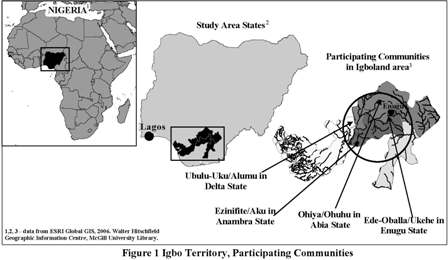IGBO, NIGERIA
Community Food System Data Tables
Introduction
 This field study was carried in Southeastern Nigeria where the Igbo culture group represents one third of the population. Eight communities, in four states, participated in the study: Ohiya & Ohuhu in Abia State, Ezinifite & Aku in Anambra State, Ubulu-Uku & Alumu in Delta State and finally Ede-Oballa & Ukehe in Enugu State (Figure 1). Each state has particular ecological characteristics, and foods consumed vary based on soil quality, rainfall and other factors.
This field study was carried in Southeastern Nigeria where the Igbo culture group represents one third of the population. Eight communities, in four states, participated in the study: Ohiya & Ohuhu in Abia State, Ezinifite & Aku in Anambra State, Ubulu-Uku & Alumu in Delta State and finally Ede-Oballa & Ukehe in Enugu State (Figure 1). Each state has particular ecological characteristics, and foods consumed vary based on soil quality, rainfall and other factors.
According to Nigeria’s National Census (1991), the Igbo cultural group accounted for 25 million of the 88.9 million people in the country. Although there are diversities and variations in the Igbo culture, there is a common basic culture centered on a common language, institutions, religious and cosmological beliefs. Agriculture is a heritage occupation and remains quite traditional with small sized farms, and rain-fed crop production. All crops cultivated are used as food. Nonetheless, both protein-energy and micronutrient deficiencies are a public health problem. This study aimed at documenting the Traditional Food Systems of Igbo.
Research Team
The study team was comprised of the following:
University of Nigeria
- Dr Elizabeth Chinwe Okeke (Principle Investigator)
- Dr Henrietta Nekechi Ene-Obong
- Dr Anthonia Obianuju Uzuegbunam
- Alfred Ozioko
- Simon I. Umeh
- Nnaemeka Chukwuone
Community Leaders
- Eze Ohanyere I (His Royal Highness, Abia State)
- Ichie Godwin Ezeoke (Prime Minister, Anambra State)
- Chief I.S. Ofolue Ozoma (His Royal Highness, Delta State)
- Igwe P.E. Eze (His Royal Highness, Enugu State)
Center for Indigenous Peoples’ Nutrition and Environment (CINE), McGill University
- Dr Harriet Kuhnlein
Notes on research methodology
The study was carried out from June 2004 to June 2005. One hundred households per community were randomly selected for individual interviews and food frequency questionnaires. Additionally, two 24 hour recalls, one for the mother and one for child in each household were conducted. Chiefs of the communities and the elders collaborated as key informants and guided researchers on picking knowledgeable persons for focus group discussions and other information.
Voucher samples of plants were collected, processed, preserved and identified during field visits and were sent for verification to the Department of Botany, University of Nigeria, Nsukka.
Notes on food groups
Users should know that the data presented here do not represent absolute values. The purpose of this publication is to present a true reflection of the usual composition of foods as available and/or consumed among Igbo community members. This is a living document and nutrient information will be added and/or updated when available. Traditional Igbo foods were divided into the following food groups:
- Fruits
- Legumes, Nuts and Seeds
- Meat, Poultry and Eggs
- Soups, Condiments and Thickeners
- Vegetables and Mushrooms
Notes on the laboratory analyses
The analytical procedures of the Association of the Official Analytical Chemists (AOAC, 1995) were used in the University of Technology, Akure, and the University of Nigeria laboratory for analysis of samples.
- Energy was calculated using Atwater factors
- Protein was determined by the Kjeldhl Method
- Fat was determined by the Soxhlet Extraction Apparatus
- Carbohydrate was back calculated
- Fiber was determined by weight after enzymatic treatment of starch and protein
- Moisture and ash were determined by weight
- Iron, zinc and calcium were measured using Atomic Absorption Spectrophotometer
- Ascorbic acid was obtained using the 2,6 dichlorophenolindophenol method
- Beta carotene was determined by High Performance Liquid Chromatography
- Folic Acid was determined with a microbial method using lactobacillus after samples were hydrolyzed
Where possible, the Scientific and English names, harvest period, seasonality of use and preparation of these foods are also documented.
Notes on food components
There are approximately 18 to 20 components in the main body of the tables, which are presented in a fixed format for each record. The order of presentation is based on major nutrients categories. Vitamin A values are reported in both Vitamin A retinol equivalents (RE-μg) and in retinol activity equivalents (RAE-µg).
In the tables, beta carotene values are back calculated with the understanding that the Vitamin A values supplied are in Vitamin A retinol equivalents (RE-μg). Vitamin A retinol activity equivalents (RAE-μg) are also calculated and reported to make them merely compatible with the DRI (Dietary Reference Intake) recommendation.
Vitamin C, riboflavin and niacin values were supplied on a dry matter basis. In order to be consistent with other nutrient values reported in the tables, the value for these nutrients are calculated and reported on a fresh weight basis.
